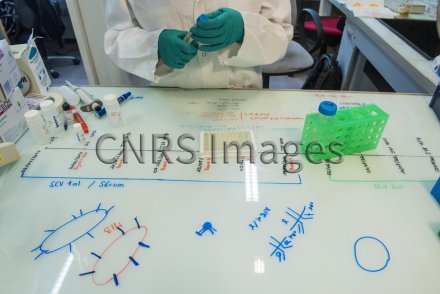Production year
2017

© Hubert RAGUET / Institut Cochin / CNRS Images
20170080_0017
Mucosal vaccination protocol drawn on a counter top, used to vaccinate rabbits to evaluate in vivo the induction of an antibody immune response that protects against HIV. The vaccinated rabbits are then subjected to different doses of antibody as part of the development of a prophylactic vaccine against HIV. The "Mucosal entry of HIV and mucosal immunity" team led by Morgane Bomsel has set up an IgA mucosal antibody combinatorial library using genital mucosal cells from women with high exposure to HIV (HESN - highly exposed seronegative), but who are protected from infection thanks to the HIV-specific IgAs found in their genital mucosa. Research scientists are aiming to characterise the regions of the virus recognised by these protective IgAs and use them as an immunogen to develop a prophylactic vaccine that reproduces the protective response observed in these HESN patients. A vaccination test in monkeys using a vaccine based on the parts of the virus recognised by these IgAs was found to protect the vaccinated monkeys completely from repeated experimental vaginal infections. These pre-clinical studies were followed by a phase 1 clinical trial in which the vaccine succeeded in inducing IgA antibodies, shown to protect against the virus during in-vitro tests, in the vaccinated women. A clinical study in humans (women and men) on a larger scale using this same vaccine is currently being prepared.
The use of media visible on the CNRS Images Platform can be granted on request. Any reproduction or representation is forbidden without prior authorization from CNRS Images (except for resources under Creative Commons license).
No modification of an image may be made without the prior consent of CNRS Images.
No use of an image for advertising purposes or distribution to a third party may be made without the prior agreement of CNRS Images.
For more information, please consult our general conditions
2017
Our work is guided by the way scientists question the world around them and we translate their research into images to help people to understand the world better and to awaken their curiosity and wonderment.